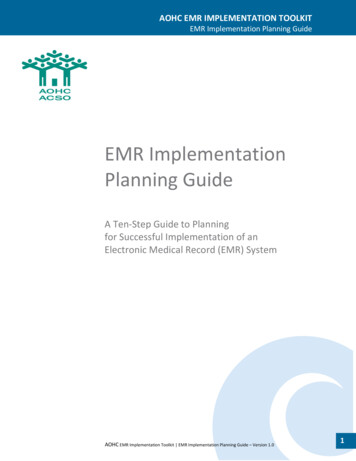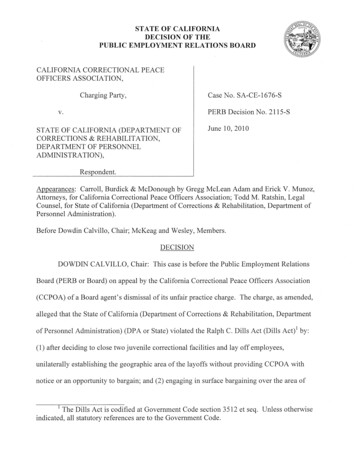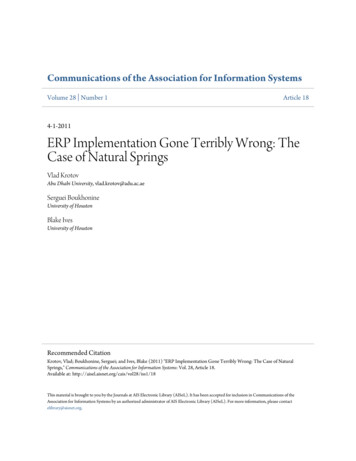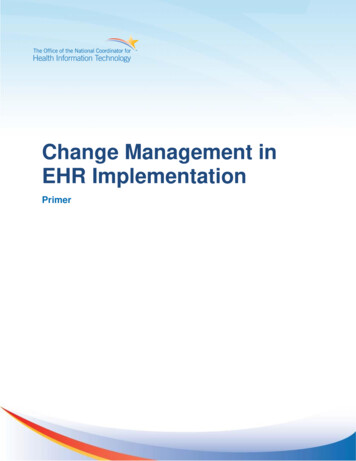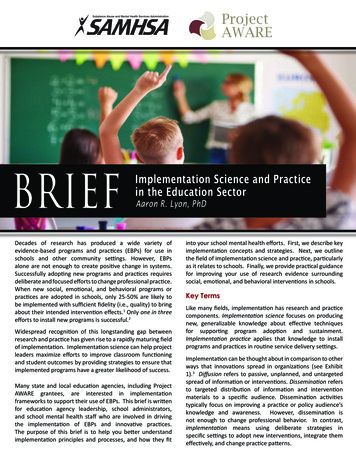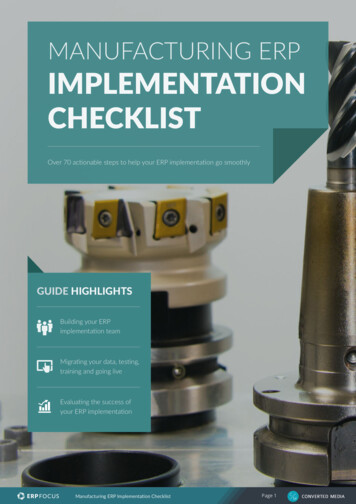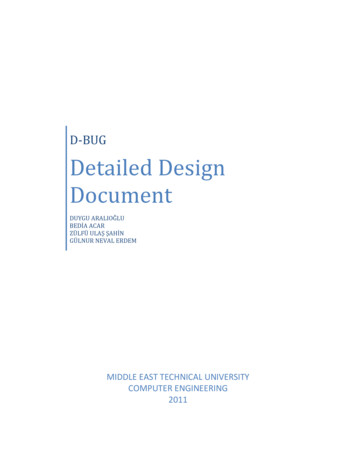
Transcription
IT 12 004Examensarbete 30 hpFebruari 2012Design and Implementation ofa Web-Based Tourism InformationManagement System: Travel-SYSZhang ShuoInstitutionen för informationsteknologiDepartment of Information Technology
AbstractDESIGN AND IMPLEMENTATION OF AWEB-BASED TOURISM INFORMATIONMANAGEMENT SYSTEM: TRAVEL-SYSShuo ZhangTeknisk- naturvetenskaplig orietLägerhyddsvägen 1Hus 4, Plan 0Postadress:Box 536751 21 UppsalaTelefon:018 – 471 30 03Telefax:018 – 471 30 00Hemsida:http://www.teknat.uu.se/studentAs tourism has become one of the most promising industries in the world, tourisminformation management systems have become increasingly popular. People are moreand more dependent on such systems nowadays. The systems themselves haveevolved, from being systems in which the users can only accept information passively,to systems which aim to integrate the users as an important part of the system. Theusers can be information providers as well, i.e. share what they have learned fromtheir travel. The aim is to build an open, unified standard, and a well-functioningplatform for all users.This project follows the software development process, i.e. requirement collection,system design, detailed design, database design and finally implementation and testing.The UML language is used to model the system, and for analysis of the functional andthe non-functional requirements. Moreover, the project uses the .NET framework,C# language and the SQL Server 2005 DBMS to implement the web based tourisminformation management system.The system includes an information sharing platform, which allows sharing of userexperiences for all users. In addition, the system employs a two-dimensional usermanagement model, which allows not only authority management but alsomanagement of the scope of the user's authority.Handledare: Quingfeng DuÄmnesgranskare: Ivan ChristoffExaminator: Anders BerglundIT 12 004Tryckt av: Reprocentralen ITC
Table of Contents1 Introduction . 51.1 Background. 51.2 Related work . 61.3 Thesis Purpose . 71.4 Thesis Outline . 52 Requirements Analysis . 92.1 The overall system requirements . 92.2 Feasibility Analysis. 102.3 Functional Requirements . 112.3.1 User Requirements . 112.3.2 Administrator Requirements . 142.3.3 Requirements of Vendors . 152.4 Non-functional requirements . 162.4.1 Performance Requirements . 162.4.2 Usability Requirements . 172.4.3 Security Requirement . 182.5 System Data Analysis . 192.5.1 Data Requirements. 192.5.2 E-R Diagram . 203 The design of Travel-SYS System . 233.1 Overall Design . 233.1.1 Design Principles . 233.1.2 Overall System Structure . 243.2 Design of Two-dimensional User Management Model . 25
3.3 Detailed Design of the System . 263.3.1 Hierarchical Management Module of Attractions . 263.3.2 Basic Information Management Module of Attractions . 273.3.3 Image Management Module of Attractions . 293.3.4 Travels Management Module of Attractions . 303.3.5 Vendors Information Management Module . 313.3.6 User Management Module . 324 The implementation of Travel-SYS System . 354.1 Realization of attraction hierarchical management module . 354.2 Realization of attraction basic information management module 394.3 Realization of attraction picture management module . 415 Summary & Outlook . 545.1 Summary. 545.2 Outlook . 55References . 56
Chapter 1 Introduction1.1 BackgroundDuring recent years tourism has become one of the world's largest and most powerfulindustries. With the expansion in tourism, the application of information technologyin that area has also developed rapidly. Traditional management tools usuallyartificially manage text, icons and pictures, and make decision through these. But, intoday's fast-developing environment, traditional management cannot meet the demandof updating speed, and it has significant limitations in saving and data modification,and also data would easily be missing. All the shortcomings can lead to inaccurateinformation, as a basis for managers and decision makers. Tourism informationmanagement systems can be developed to meet these growing needs.A tourist information management system is a product which is required whentourism develops to a certain stage[9].It allows tourism resources to be effectivelymanaged, offers timely and accurate travel information to travelers, and providestourism management departments the basis for tourism planning and decision-makingin order to improve their efficiency.As China's economy rapidly develops and the people‟s income increases, more andmore people choose tourism as a way of spending their leisure time, with self-tourismbecoming the major trend.[10]Inthis case, many travelers highly depend on touristinformation services. They need to search for as much information as possible to helpmaking their decisions, including itinerary, transportation, hotel and so on. Expertspoint out that a travel decision-making of tourist, in fact, is a process including touristinformation input, processing, output, and feedback.[11]Therefore, this put forward agreat demand on large amount of high-quality easy-to-get tourism information.Web-based tourism information management system can well meet the demand, inwhich database is used to store large amount of tourism information, and web pagesare used to present the information. Besides, search engine is incorporated to providepowerful search capability. Different from traditional information management5
systems, the new tourism information management system we developed hasincorporated the web 2.0 concept, which supports timely updates of information.Users not only can get good information service from the system, they can also easilyupload new information to the system, thus providing service to other users. In thissystem, users can interact with each other, sharing tourism information moreeffectively.1.2 Related WorkTourism has become one of the world's largest industries, creating an annual value of 3,000,000,000,000 in the world.[11]It has been predicted that telecommunications,information technology and tourism will be the driving force of economicdevelopment in twenty-first century service industries. A great deal of effort has beendone on the construction of travel information system in the past decades in the world.International airlines, travel companies and hotel industry companies haveexperienced several major information technology transformations. The first wascomputer location system SABRE, which is the seed of tourism informationdevelopment. The second was launched in 1978, in which the United States cancelledair traffic control bill, so that tourism increases the range of choice to purchase tickets.This also cause the computer reservation systems be extended to cover travel agents.The third time was travel agent established specialized banks checkout method tocomplete the payment and settlement.[9]In the last, which is currently being inprogress, various tourism destination information systems are being constructed anddeployed, providing comprehensive information of six elements: food, shelter,transportation, travel, shopping and entertainment with the function of query, retrieval,and booking, all in one system.In China, however, professional tourism information websites appeared much laterthan in the world, in about 1995. Before this, tourism information in Chinese can besearched only from China's domestic Internet portals, such as Sina or Sohu. Theinformation gathered is mostly from non-professional websites, which is very generalin description, fragmental and often out of date. Nevertheless, many travel websiteswith intensive information have appeared in the past decade, they can provide muchmore comprehensive and systematic information on tourism and tourism-related6
business than in the past.According to the purposes and information distribution,China's domestic tourism websites can be divided into the following three categories:1. Regional tourism websitesThe websites built by local governments, such as province governments, primarily tointroduce the scenery in the region. These websites also provide a simple platform forvisitors to communicate with the government or the related departments. Thedrawbacks of these websites are: (1) the information is limited to the region theyconcern; (2) the information is relatively out of date, due to the reason that they don‟tupdate frequently; (3) the quality of information needs to be improved.2. Professional travel websitesThese websites are called professional because they provide nearly all kinds ofinformation about travel,including hotels, ticket booking, destination guides, andmany other travel information and more comprehensive travel services. Well knownwebsites in China include Ctrip and e-Dragon. After years‟ development, they haveenough scale and ability to ensure high quality of service. Professional travel sitestypically focus on technology development, keeping pace with technology advancesand enhancing research and development capabilities.3. Websites built by tourism enterprisesIn China, most tourism enterprises are associated with particular scenery regions,which they have the right of management. Their websites only provide informationabout their own regions. And they usually don‟t provide service of ticket booking,tourism planning, etc.1.3 Thesis PurposeIn this thesis, a web-based tourism information management system, namedTravel-SYS, is described in detail. It is designed in implemented by us in theframework of Microsoft .NET. We followed the general steps of software engineering,as follows:1. Travel-SYS requirement analysisWe conducted a comprehensive analysis of the system, including functionalrequirements and non-functional requirements analysis, which is based on a thoroughunderstanding of the operation process.7
2. The overall design of the Travel-SYSThe B/S structure with three-tier architecture is adopted, which has the advantages ofeasy to use and easy to maintain. The clear separation of presentation, business logicand data has made it much easier to extend and modify.The system is divided intosix modules: attractions level management, attractions information management,image management, travel management, business information management and usermanagement. A two-dimensional role-based user access control model is adopted,which allows for an implementation of very flexible user management.3. Detailed design of the Travel-SYSBased on the overall design, we designed the logic of each module and a collection ofspecific functions for each module. We also designed database structure and databasetables of the system.4.Implementation of the Travel-SYSThe Travel-SYS system is implemented using C# in the framework of .NET.Thedatabase used is SQL Server. We have finished all the programming and debugging. [7]1.4 Thesis OutlineThe report is organized as follows. Chapter 2 presents the requirement analysis.Chapters 3 and 4 describe the design and the implementation of the system,respectively. Finally, some concluding remarks about the results from the project aregiven in Chapter 5.8
Chapter 2 Requirements AnalysisRequirement is what a particular product must meet, which is an indispensable featureof the product. Two being reasons for this: one is that products must obtain somefunction and quality; the other is customers expect such requirement to be a part ofthe products delivered. Requirements analysis includes a series of processes and itsultimate goal is to locate a customer or user‟s needs.[1]After collecting, extractingand summarizing the needs, the requirement will be patterned to form a requirementspecification, which serves as the foundation for following software developmentsections.Requirements analysis is receiving increasing attention and becomes a very long,complicated section in project cycle, during which experts talk with their customers,write down the conversation results, analyze the collected information, extract keypoints, sum up a general concept, and then discuss the identified problems with thecustomers. This process can be repeated and across the entire life cycle of someprojects.Requirements specifications, i.e., documentation generated during the requirementsanalysissectiongenerally rements and design constraints, etc.2.1 The overall system requirementsThe Web-based tourism information management system (“the System”) is an openplatform which integrates tourists, vendors and tourism-related information resources.The System is designed to provide an information management system which istourism-relevant, well-structured and with high satisfaction in user experience. TheSystem can meet visitors‟ needs of pre-travel planning and post-travel experiencesharing. It also provides basic travel information, pictures, and travel notes sharingfunctions, etc. With the System, vendors can expand their business scope and provide9
better service with reference to visitors‟ feedback. Vendors' information becomes aseamlessly integral part of travel information. The web-based tourism informationmanagement system should have the following basic features:1. High IntegrationWeak points like imperfect connection of vendors‟ information with attractioninformation and limited operation of post-travel experience sharing generally exist inprevious systems. The System is committed to narrowing the gap between tourists‟and businesses‟ perspectives and integrating needs of pre and post-travel, thusproviding more efficient and reasonable access to travel information.2. High UsabilityThe System must have high usability because they are for the general public andtravel enthusiasts. The interface should be simple to avoid ambiguity. Page-leveldistribution should be clear and common functions should not be buried in the bottomlayer structure. The accurate and real-time information also affects the System'susability.3. Complete FunctionsThe System shall meet general needs of ordinary users. It provides the informationcollections from food, housing, transportation to the attraction itself, which arenecessary for tourism activities. After traveling, the System provides tourists aplatform to share experiences including photos, travel notes and reviews. Loss ofusers due to functional defection should be avoided in the early days when the Systemis on line.4. SecuritySecurity is a generally considered factor for all systems, including confidentiality ofusers‟ and businesses‟ information, database backup, network security and othersafety factors. Detailed description is presented in the section of non-functionalrequirements.2.2 Feasibility Analysis1. Technical feasibility10
The System is to be developed with Microsoft. NET framework, adopting visualstudio 2008 as the development software, C # as programming languages andMicrosoft SQL Server 2005 as database software, all of which are the most commontechnology portfolios and have been widely used in various network applications ande-commerce.[3]Relevantinformation and knowledge have also been popular with agreat deal of reference information and data available.NET Framework provides a defined set of technical specifications and a range ofsupport products, including NET class libraries, ASP.NET, and Visual Studio and soon. NET makes project development more efficient and easier to operate. [12] [13]2. Economic FeasibilityThe System is of relatively shorter development cycle, uncomplicated functions andno technical bottlenecks. Thus, the economic requirement of the System‟sdevelopment can be expected to be low. The tourist information platform system stillhas tremendous space to develop. For the System, the vendors‟ information will bemore meaningful and purposeful when the number of users reaches a certain size.Vendors‟ registration will become an economic source for running the platform, forthey have to pay fees to obtain membership. This is one of the operational strategiesof this Tourism Information Management System.2.3 Functional Requirements2.3.1 User RequirementsTravel-SYS aims at providing users with comprehensive and high-quality touristinformation service. Figure 2-1 shows the user's use case diagram.Services achieved are as follows:11[4]Functional
Figure 2-1 User‟s Use Case Diagram1. RegisterVisitors use their e-mails as the sole identifiers to register. Fill in e-mail, password,and re-enter the password when register.2. User LoginUsers need the e-mails and passwords to log into their main interfaces.3. Query and Browse DestinationsVisitors can find destinations in the hierarchical structure without register.Destinations are arranged in a Province - City – Attractions structure, in whichprovince, city and attraction pages are separated. Attraction is the smallest unit. In theattraction page, visitors can browse its general introduction, traffic information,weather, attraction evaluation, attraction pictures, travel notes and the information ofsurrounding commercial facilities.4. Upload PicturesUsers can choose to upload pictures in their own interface after login and sharephotographs with others. Figure 2-2 is a sequential diagramphotographs.5. Upload Travel notes12[4]for users to upload
Users can choose to upload travel notes in their own interfaces after login and sharetheir travel experience. Visitors can share their latest and most reliable travelresources with others by writing travel notes after traveling.6. Delete Pictures, Travel notes or CommentsAfter login, users can see their previously uploaded travel notes, pictures or commentsin their own interfaces. If they want to delete them for some reason, they can choosethe delete link.7. Modify Pictures or Travel notesAfter login, users can see their previously uploaded travel notes, pictures or commentsin their own interfaces. They can choose the modify link if they want to modifypictures or travels for some reason.8. Comment on Others’ Photos or Travel notesAfter login, users can comment pictures or travel notes and communicate with otherusers through commenting their pictures or travel notes.13
Figure 2-2 Sequential Diagram9. Rating Pictures, Travel notes, or AttractionsAfter login, users can rate pictures, travel notes and attractions which they havebrowsed. Rating reflects how much the public like the picture, travel note or attraction.Users can express their own views to provide reference to others. This is a veryimportant feature of the web 2.0, which users can participate in, rather than justpassively receiving information of. Thus, users have become the information provideras well.2.3.2 Administrator RequirementsThe administrator is responsible for controlling the system‟s proper operation. Figure2-3 is a use case diagram [4] for administrators.Figure 2-3 Administrator Use Case Diagram1. Add / modify Province - City - Attractions InformationTourist attractions are logically organized in Province - City - Attractions hierarchyaccording to geographic location. The administrator is responsible for maintainingsuch hierarchy. When new attraction needs to be added, the administrator should addintroduction, traffic information, and weather conditions for the new attraction on thenew attraction‟s page. When attraction information is updated, the administrator canmodify the tourist attraction information page.14
2. Management of User AuthorityTwo-dimensional user management model is adopted here. High-level administratorscan authorize low-level administrators. The administrator can allocate his/herjurisdiction and authority. In the user management interface, administrators canchoose the authority-adding link to authorize operations. Administrators can forbidordinary users‟ operations for some reason as well.3. Management of vendors’ InformationAdministrators need to review and approve the application submitted by vendors so asto ensure the correctness and relevance, and also guarantee user's interests. Theapproved information should be added to the related web page and open to users.Administrators are to monitor the information which includes its validity and userfeedback on the vendors.4. ReviewNetwork platform system has a large degree of freedom. In order to ensure the legalityof the content submitted by users, the administrator has to review the whole system.This review includes each administrator‟s review within their responsible scope.2.3.3 Requirements of VendorsQuality of food, accommodation, and transportation directly relates to the quality ofthe whole trip. Figure 3-4 is a vendor use case diagram. Vendors provide visitors withservice information of the surroundings, which includes catering, accommodation,local travel agency services. In this way, vendors‟ information is promoted and bringsconvenience to users as well.Figure 2-4 Vendor Use Case Diagram1. Submit ApplicationVendors need to fill out an application if they want to move from general user into a15
vendor. Contents of the application form include business type, name, location, andrelevant introduction. The submitted form will be reviewed and approved byadministrators of the scope.2. Add / Edit Business InformationVendors can manage their own information page, such as providing pictures and textsabout products or promotions.2.4 Non-functional requirementsNon-functional requirements are necessary for products and directly affect acceptanceof the product. They make products attractive, easy to use, fast, reliable and secure.The existence of such property is not because they are the basic functions of theproduct, but because customers want these functional activities to achieve a particularquality. Non-functional requirements describe product features such as userexperience, product‟s appearance or usability.2.4.1 Performance RequirementsAs for web-based information systems, performance requirements can help designersand developers to define system behavior under different loads. Performance is oftenan important criterion to measure usability of the system. The most important thing ofuser experience is often relevant to performance, including waiting time, throughput,and stability and so on. Travel-SYS system should meet the following performancerequirements:1. Response TimeThere has always been a variety of definitions for response time of the performancerequirements. A more common definition counts from when the user sends a requestto when the last byte reaches the user‟s end. Page response time means the timerequired to load a page. The time unit is normally second or millisecond. Averagepage response time of the system should be within 3 seconds.2. System CapacityIn the first version, Travel-SYS system should be able to support about 4,000registered users. Sufficient database space is required. In addition, the system shouldsupport over 1,200 simultaneous online users and allow 400 concurrent users. [8]3. Stability16
Stability needs a long time to reflect and is used to measure declining rate of thefigure of performance after long-running. System with poor stability may result inmemory leak or the database transaction log overflowing. Stability requirements ofTravel-SYS are moderate with respect to enterprise information system. Systemadjustment is allowed when page views are rare, such as in early morning.2.4.2 Usability RequirementsUsability requirements make the products meet the needs of the user's ability andexpectation to use. Usability will influence efficiency and error rate of using theproduct as well as acceptance of new products. Sources of usability requirementsresult from the following two factors: one is the required usability level of the product,and the other is user's expectationsIn the specific circumstances of the information system, there is no customer andusers are the visitors. In order to satisfy the users‟ experience demand, thisinformation system should meet the following points:1. Easy to useTravel-SYS system should be easy enough for any ordinary user who, if has noprofessional background, can achieve necessary function through the informationprovided on page. Users can complete an objective without excessive page jumpactions. Because too many clicks and jumps easily lead to confusion, which makes theuser tend to forget the initial purpose. Users should clearly know what can beaccomplished through this system, such as browsing the travel notes, rating scenicspots and so on. All functions are located in the appropriate place of each page toensure that users can see and hold an overview of the whole function.2. Easy to learnThe biggest difference between easy to learn and easy to use lies in that learning touse the system is difficult in the beginning, but once master it, using the system willbecome very easy. Travel-SYS is in accordance to web 2.0 features and is easier touse compared to early passive acceptance of information. In the initial adaptationphase, users can learn how to use all functions according to suggestion and help in ashort time.3. Low Error RateTravel-SYS system is required to help users minimize the number of errors. Importantfactors involve providing users interface and context which are consistent with daily17
habits and clear navigation, etc. Help information is also very critical and should beprovided in appropriate place. When error occurs, the system can correct the error orreturn to the previous step, which also means good performance of the systemrobustness.4. EfficiencyEfficiency requirement of the system can be measured by the time taken to complete atask or the average number of tasks completed in unit time by users. Efficient userexperience will directly increase customer satisfaction. Efficiency of the system canbe divided into two parts: efficiency of the user-controllable and the efficiency of thesystem itself. Reasonable interface layout, buttons, and logical hierarchy enable highoperating efficiency for users; background processing and connectivity speed ofdatabase will affect the efficiency of the system itself.5. High User SatisfactionUser satisfaction, a more or less abstract measure, means that users enjoy using thesystem and fell satisfied with the whole process. As for Travel-SYS system, thenumber of registered users can be regarded as a measure of satisfaction. If users arewilling to use the system as a travel information search platform and share theirexperiences with others on this platform, user satisfaction will prove to be high. Inaddition, user's feelings can be obtained through customer satisfaction investigation.2.4.3 Security RequirementSecurity requirement is a critical requirement, for big risks may be brought byproducts that fail to meet security requirement. Security of system information tendsto be even more important nowadays when the Internet wins wide popularity. Securityinvolves confidentiality, availability and auditing.1. ConfidentialityConfidentiality means that only authorized users have access to data. Who is theauthorized user and under what circumstances the authorization is valid must bespecified. After given a role by the administrator, a user turns into an authorized userwithin his/her competence. The high-level administrator can authorize the low-leveluser roles and specify available time of the roles. Higher administrators can onlymanage their subordinate administrators.2. AvailabilityAvailability refers to that the authorized user can have access to data without18
limitation, which means data will be
six modules: attractions level management, attractions information management, image management, travel management, business information management and user management. A two-dimensional role-based user access control model is adopted, which allows for an implementation of very flexible user management. 3. Detailed design of the Travel-SYS
